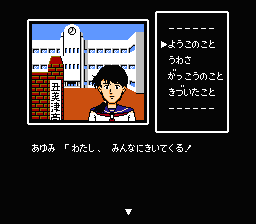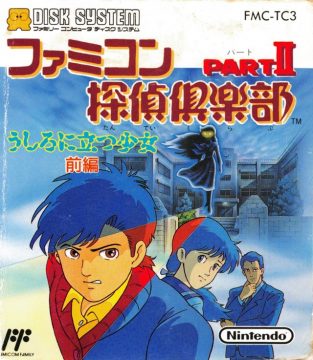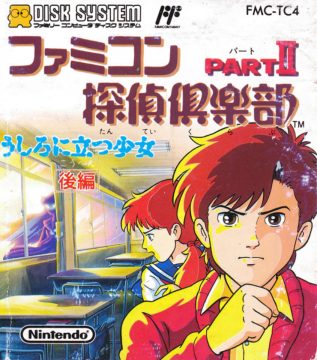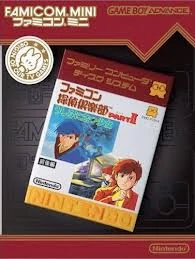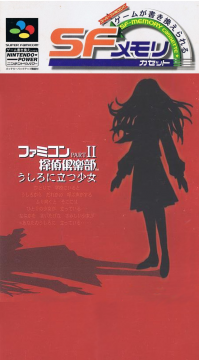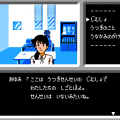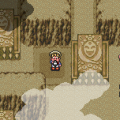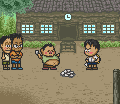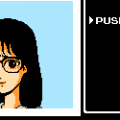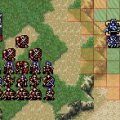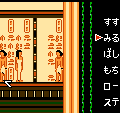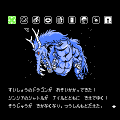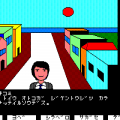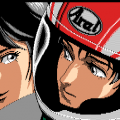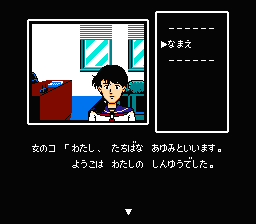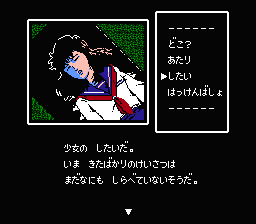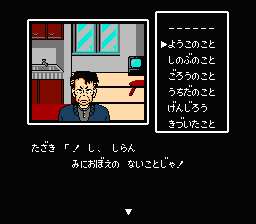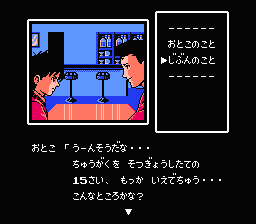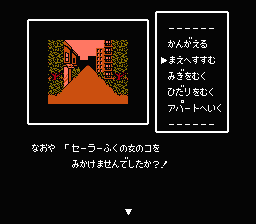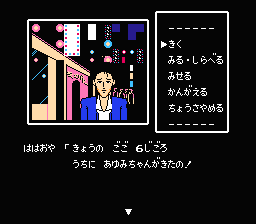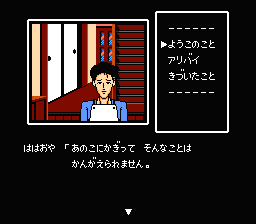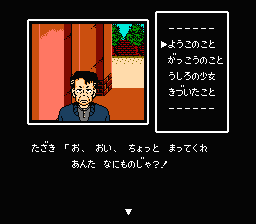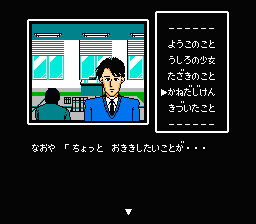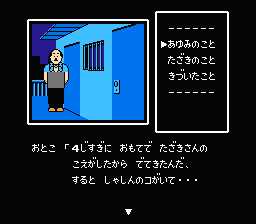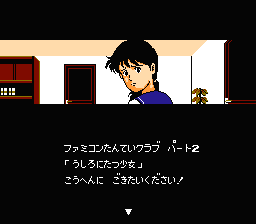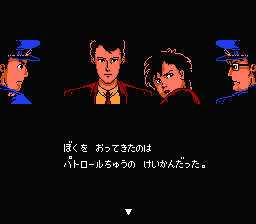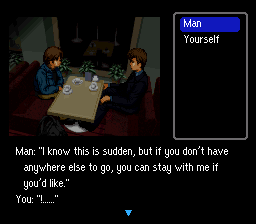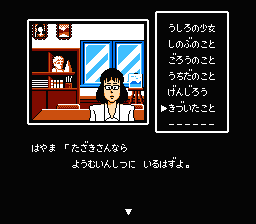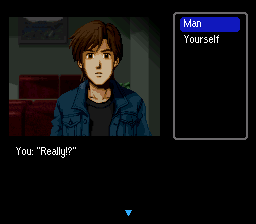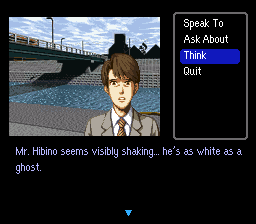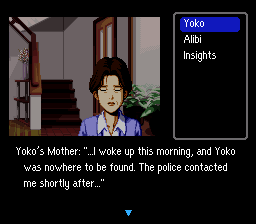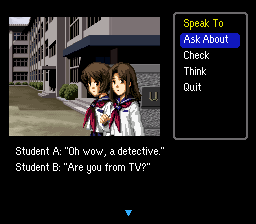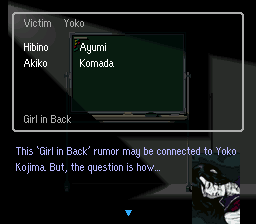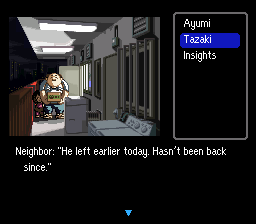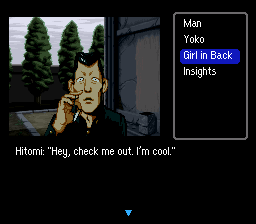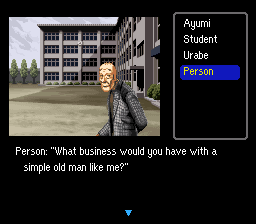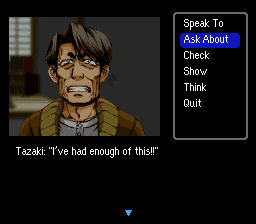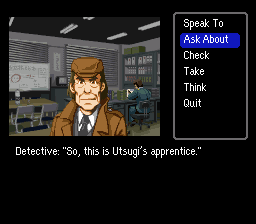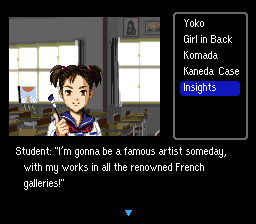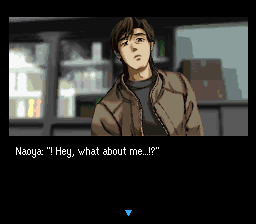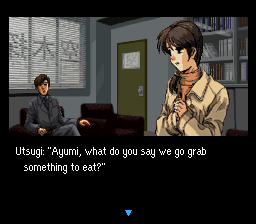- Famicom Detective Club: The Missing Heir
- Famicom Detective Club Part II: The Girl Standing in the Back
- BS Detective Club: The Past that Disappeared in the Snow
- Famicom Detective Club (Switch Remakes)
This article covers the original Famicom and Super Famicom versions. For the Switch remake, please see the upcoming Part 4.
Famicom Tantei Club Part II: Ushiro ni Tatsu Shoujo (“The Girl Standing in the Back”) was released for the Famicom Disk System in 1989, one year after the release of the first game, and again came on two double sided disks. Despite being named Part II and thus implying that it would continue from a cliffhanger from the first part, this game is a prequel to Famicom Tantei Club: Kieta Koukeisha that tells the story of how the protagonist met Ayumi Tachibana and their first case together. For players in the West, Ushiro ni Tatsu Shoujo was until the 2021 Switch remake the only game in the series that could be experienced in English thanks to a 2004 fan translation patch by Neo Demiforce and Tomato for the Super Famicom remake of the game. The choice of translating this game and not Kieta Koukeisha (and the fact that no other fan translation group has done it since, FDS rom hacking challenges aside) is telling for what the eventually will be the bottom line of this review: Ushiro ni Tatsu Shoujo is a more skillfully crafted game than its predecessor and a better entry point for players wanting to see what the series is about.
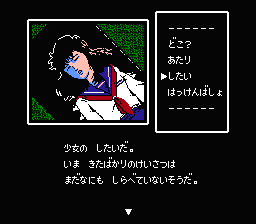
The game is set two years before Famicom Tantei Club: Kieta Koukeisha when the orphaned 15 year old protagonist has just been taken on as a junior assistant by private detective Shunshuke Utsugi. One morning, a schoolgirl is found dead in the city canal and the two are called in to aid the police with the investigation. Being busy with another case in which the statute of limitations will run out next week, Utsugi hands the case of the murdered school girl to you. The victim, Yoko Kojima, was a student of Ushimitsu High School, and teachers and students attest that Yoko had been acting differently lately. You soon learn that Yoko and her best friend Ayumi Tachibana had started an extracurricular “detective club” (like how Japanese high schools often have a sports club, chess club, manga club etc.) and had been busy solving a number of cases. The case she was working on when she died, however, regarded an old rumor about a girl who died at Ushimitsu High School and since then has been haunting the buildings, appearing as a ghost standing in the back of classrooms and hallways. Not before long, you figure out that Yoko’s death might have a connection to the old case Utsugi is working on, and as if that wasn’t enough, Ayumi’s eagerness to help the investigation on her own soon begins to have consequences for the case.
You don’t need to play very long to see that this is a livelier and better paced game than the first game. Compared to Kieta Koukeisha most aspects are improved: the graphics look better, the soundtrack is more varied and has some really memorable tunes, the character sprites have more personality, the dialogue is snappier and suffers less from exposition dumps, and the storytelling is generally more focused while still managing multiple subplots. Ushiro ni Tatsu Shoujo is perhaps a more minimalist experience than its more sprawling, Agatha Christie-styled predecessor in the sense that it mostly takes place in and around the high school, but the narrative is far better off for it. It is clear that the team learned a lot from making the first game and was able to produce a much tighter gameplay experience for the sequel. Another great improvement on the first game is the character of Ayumi. In the first game she is mostly just “that other teenage detective prodigy” at Utsugi Detective Agency who helps you with gathering information in parallel to your on-site investigations and is a sounding board to discuss your findings with. However, in the first game she never leaves the office and was on the whole an underused character. Ushiro ni Tatsu Shoujo gives her much more agency by having her be directly involved in the events and having her own agenda, and the resulting dynamic between her and the protagonist is a key reason as to why this game functions better than the first.
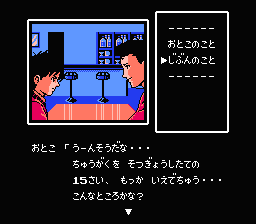
The first game had a “Remember” command related to the amnesiac subplot that allowed you to recover fragments of memories as you discovered new leads in the investigation. In Ushiro ni Tatsu Shoujo this was replaced with a “Think” (かんがえる [kangaeru]; to think, to contemplate) option, which when used at the correct time and place prompts the protagonist to deduce what he needs to do next. Compared to the “Remember” command, this one often feels artificial and redundant, since the protagonist tends to “think” during the dialogue sequences and “investigate” commands anyway. Having to manually select “Think” to progress the game where an automatic progression or a different command (“Talk”, “Investigate” etc.) would have worked just as well, makes the game feel a little clunky at times. Another small quirk is how the game sometimes tries to simulate the passing of time when waiting to speak with people that are busy by having you do some menial investigations of the current location(s) in the meantime; it should come as no surprise to fans of the Japanese Adventure (ADV) game genre that the best way to get through these sequences are to exhaust all menu options to try to trigger all required flags. Like in the first game, there is also a 3D maze in here as well, and while it manages to get away from the box-like corridor style of most 3D mazes from the 80s by being set in a suburb, the flags you need to trigger in the maze to solve it are possibly even more obscure than in the first game (the SFC remake got rid of this section in favor of a montage, which says a lot). Nevertheless, given the rather short runtime of the game (5-10h depending on how fast you can read Japanese) and the otherwise great game design, all these issues are minor and should not dissuade new players interested in trying the game.
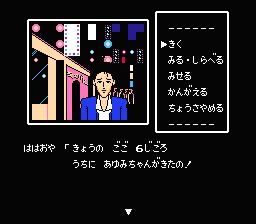
The game was remade for the Super Famicom (SFC) in 1998 with series creator Yoshio Sakamoto as director. It was released for the Nintendo Power-cart accessory, which was basically the SFC equivalent of the Famicom Disk Writer (a kiosk in certain stores where you could download games to disk, or in the SFC case, to a flash cart). The graphics have been completely remade and are brilliant, especially with the added scrolling and lighting effects. The character sprites look excellent, and it is interesting to compare the hair and clothing fashion between the FDSs version’s 80s-manga look and this late 90s SFC-sprite work. The story is ultimately the same as in the FDS version with only minor alterations. You now have access to a notebook, where you can read summaries of characters you have encountered, and at certain points you are asked to answer some questions based on these notes, which is a nice way of making the player take part in the protagonist’s deductions. There are also a few new multiple-choice sections, which have no bearing on the story progression but change the outcome of a post-credits personality assessment based on the player’s actions that measures your compatibility with Ayumi. Selecting options that she approves of throughout the playthrough will result in the best relationship with Ayumi, and failing to do so will instead pair you up with other girls you meet throughout the story instead. It’s an unnecessary but fun little addition, but it would ultimately have been more interesting if the multiple-choices actually led to alternative paths through the game, even minor ones.
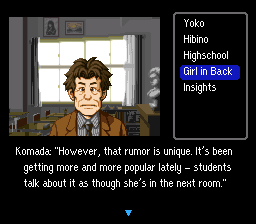
SFC
Nintendo has from time to time referred to the Famicom Tantei Club series in other games, for instance by a Ayumi trophy in Super Smash Bros. Melee, and a minigame based on Ushiro ni Tatsu Shoujo in the DS game Sawaru Made In Wario (the Japanese version of WarioWare: Touched!). The latter is a spot-the-difference game where the player is presented with two almost identical screens from the FDS version and needs to find what object or character is different on the lower screen (all minigames in this version of WarioWare are played with the touchscreen). The minigame was changed to a Metroid themed game for the Western release, since Famicom Tantei Club had no official release outside of Japan at the time.
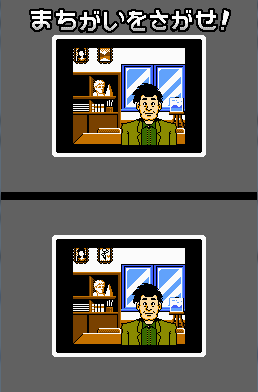
Sawaru Made in Wario (DS). The minigame instructions say: “Spot the difference”
Ushiro ni Tatsu Shoujo is easily the best game in the series and since it is chronologically the first, you can easily jump into the game without having played the first. The GBA re-release that bundles both FDS disks into one game is the easiest way to play the game if you want to experience the FDS original and are able to read Japanese. The SFC remake is very pretty and has a solid fan translation, and has until the 2021 Switch remake been the obvious way to play the game in English.
Screenshot comparisons
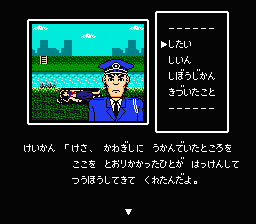
FDS
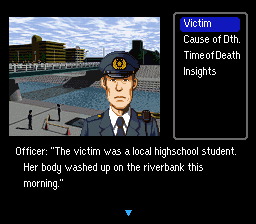
SFC
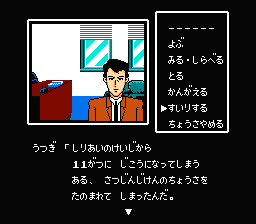
FDS
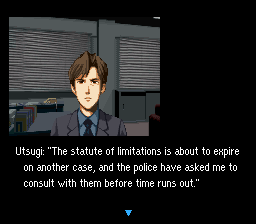
SFC
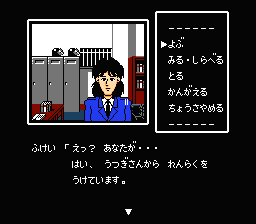
FDS
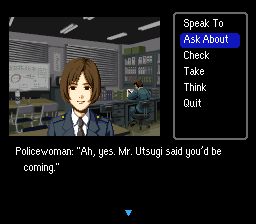
SFC
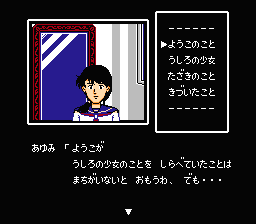
FDS
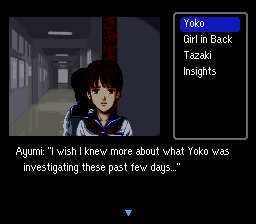
SFC
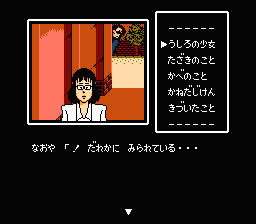
FDS
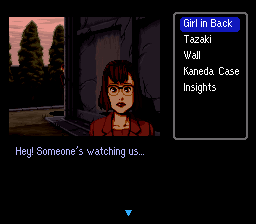
SFC
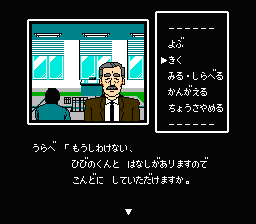
FDS
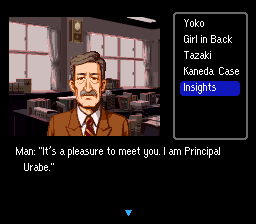
SFC
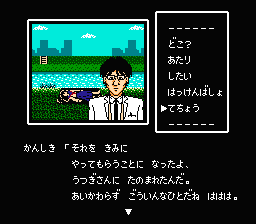
FDS
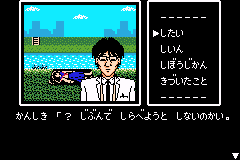
GBA
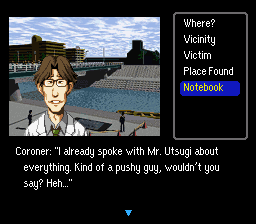
SFC
FDS GBA SFC
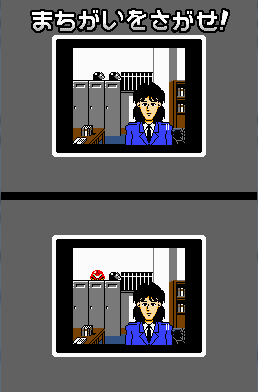
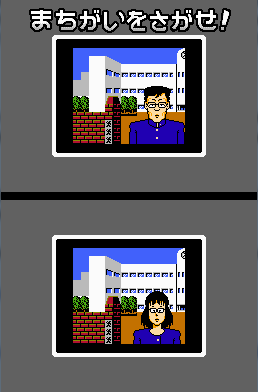
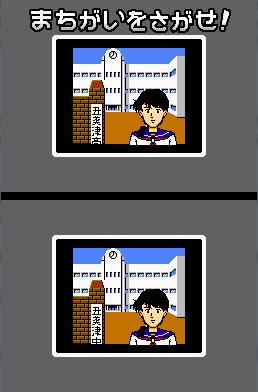
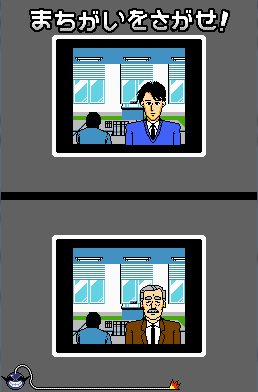
Sawaru Made in Wario (DS): some of the minigame variations

Futabasha game book
References and further reading
Previous HG101 texts and talks about this game have appeared in:
- Kalata, K. & Hubbard D. (2017) HG101 Presents: The Complete Guide to the Famicom Disk System
- Top 47,858 Games of All Time Podcast, Episode 144
High quality scans of the manuals, which among other information features excellent illustrations of the story:
Japanese blog entry about the Futabasha game book for the game, with an example of how the illustrated text looked like
https://dafe4345fsfgrghyu.blog.fc2.com/blog-entry-200.html?sp
